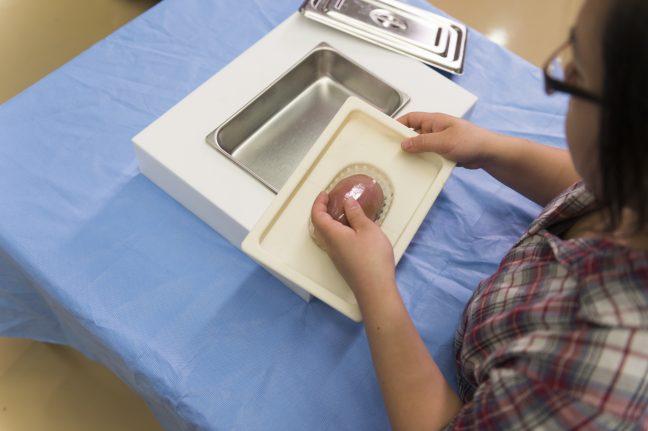Transplant surgeons can finally move out of the ice age.
Every year, 25,000 people receive a new organ. Since the ‘60s surgeons have depended on one precarious factor, ice, to make successful transplants — until now.
A team of four University of Wisconsin Biomedical Engineering Design students have created an innovative solution to eliminate the need for ice during the critical stage of cooling an organ before surgery, a process that ranges from half an hour to several hours.
Each semester, the UW BME Design program connects students with medical professionals to solve clinical problems using resources the Morgridge Institute for Research Fab Lab provides.
Biomedical engineering undergraduates Annie Yang, Monse Calixto, Alex Craig and Reed Bjork, with the help of Fab Lab senior engineers George Petry and Robert Swader created the new cooling strategy.
Instead of lying an organ directly on a bed of sterile ice and cooling solution, Morgridge Fab Lab director Kevin Eliceiri said the new design allows the surgeon to dial in a desired temperature for the cooling solution that circulates in a sterile, stainless-steel basin beneath the operating table.

Photo Courtesy of Morgridge Institute for Research
An imprinted tray, designed to fit the shape of the organ, is placed on top of the cooler to eliminate the need for an extra pair of hands to hold the organ in place and keep it chilled at a consistent temperature during operation, Eliceiri said.
Last year, UW chair of transplant surgery Dr. Dixon Kaufman and his colleague proposed the need for a more advanced and efficient organ cooling system to the BME Design program.
Kaufman, who has practiced surgery for more than three decades, wondered why, in this day in age, surgeons across the world are still using something as rudimentary as ice to preserve organs.
“Some of the best engineering can be working on an obvious challenge and realizing that a better way needs to exist,” Eliceiri said. “Usually the people that best identify these problems are those who engaged in the process.”

Photo Courtesy of UW Department of Surgery / Photographer John Maniaci UW Health
The final link: UW Hospital completes longest chain of kidney donations
Cooling an organ before transplant is imperative for removing excess fat, repairing tissues and veins, and keeping the organ stable overall before it is implanted.
But when only ice is used in the cooling process, Kaufman said surgeons do not know when the organ reaches unsafe temperature levels because ice is a highly variable and arbitrary way of cooling.
“The current system is rather crude in that we throw a bunch of ice into a bowl … and try to keep it cool to preserve [the organ] without any kind of monitoring of the temperature,” Kaufman said.
On top of that, Kaufman said the ice must be sterile because it comes in direct contact with the organ, and even then it is susceptible to melting in the operating room and cause accidental warming of the organ.
Temperatures above 39 degrees Fahrenheit, however, are “injurious” to an organ pre-transplant, so regulating temperatures precisely is an essential, but is nearly impossible to do with ice, Kaufman said.
That’s where UW biomedical engineering undergraduate seniors Annie Yang and Monse Calixto come in.
In spring 2015, Yang and Calixto, along with their fellow BME Design group members, spearheaded the project of determining how to cool the organ without ice — a challenge they were enthusiastic to undertake.
“Creating a device that could potentially help a big population [was] a really appealing aspect of the design project,” Calixto said.

Riley Steinbrenner/The Badger Herald
Yang agreed, adding that she wanted to take on a project that could serve many people, compared to the more personalized design projects she has worked on in the past.
With the help of Eliceiri and Fab Lab senior engineers, Yang and Calixto’s group designed the new cooling system that will be both effective and familiar to the surgeons.
After three iterations, both Yang and Calixto said there are still improvements to be made on the prototype, but agree it was a learning experience for the entire group.
“We are very satisfied how far the prototype has developed and have learned tremendously from the design process,” Yang said. “It is remarkable to see the development of cooling technology and how we can harness that for the specific purpose of preserving organs during the transplant procedure.”
Bill that would encourage lifesaving organ donation heads to Walker’s desk
Before it is patented on a global-scale for human implantation, however, data must be collected on how the cooling system affects tissues of large-size-animal organs, Kaufman said.
The BerbeeWalsh Foundation Prototype Pathway at the Fab Lab, which supports “unique, high impact” designs for biomedical and clinical application, Kaufman said, will continue to fund the project to provide the group with state-of-the-art equipment and resources.
Both Yang and Calixto believe the project has positively influenced their career aspirations and encourage other students to learn from leaders in their respective fields.
“Find individuals, either mentors or advisers, who believe in your potential and can help you refocus … because it’s easy to get sidetracked and discouraged due to the overwhelming pace of the college life,” Yang said. “Surround yourself with positive people, keep working hard, [and] do the best that you can.”














